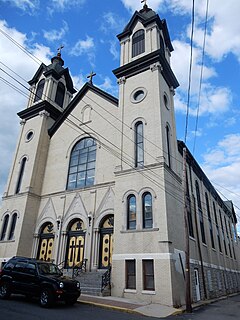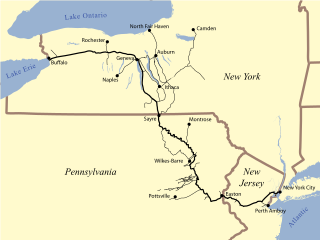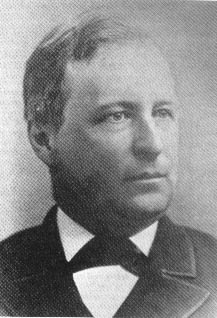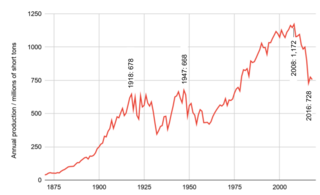
Shenandoah is a borough in Schuylkill County, Pennsylvania, United States, located in the anthracite-mining region approximately 120 miles (190 km) west of New York City and 108 miles northwest of Philadelphia. It is distinct from Shenandoah Heights, which is part of West Mahanoy Township immediately to the north.

Tower City is a borough in Schuylkill County, Pennsylvania, United States. The population was 1,346 at the 2010 census.

The Schuylkill River is a river running northwest to southeast in eastern Pennsylvania, which was improved by navigations into the Schuylkill Canal. Several of its tributaries drain major parts of the center-southern and easternmost Coal Regions in the state. It flows for 135 miles (217 km) from Pottsville to Philadelphia, where it joins the Delaware River as one of its largest tributaries.

The Lehigh Valley Railroad was a railroad built in the Northeastern United States to haul anthracite coal from the Pennsylvania Coal Region. The railroad was authorized on April 21, 1846 for freight and transportation of passengers, goods, wares, merchandise and minerals in the U.S. state of Pennsylvania and the railroad was incorporated and established on September 20, 1847 as the Delaware, Lehigh, Schuylkill and Susquehanna Railroad Company. On January 7, 1853, the railroad's name was changed to Lehigh Valley Railroad. It was sometimes known as the Route of the Black Diamond, named after the anthracite it transported. At the time, anthracite was transported by boat down the Lehigh River. The railroad ended operations in 1976 and merged into Conrail along with several northeastern railroads that same year.

Alexander Johnston Cassatt was the seventh president of the Pennsylvania Railroad (PRR), serving from June 9, 1899, to December 28, 1906.

The Reading Company was a railroad in eastern Pennsylvania and neighboring states whose final iteration ran from 1924 until 1976, when it was absorbed by Conrail.

Moncure Robinson was an American civil engineer, railroad planner and builder and a railroad and steamboat owner, who is considered one of America's leading Antebellum period civil engineers. He was educated at the College of William and Mary and at the Sorbonne; his most noted project was the Philadelphia & Reading Railroad.

The Coal strike of 1902 was a strike by the United Mine Workers of America in the anthracite coalfields of eastern Pennsylvania. Miners striked for higher wages, shorter workdays, and the recognition of their union. The strike threatened to shut down the winter fuel supply to major American cities. At that time, residences were typically heated with anthracite or "hard" coal, which produces higher heat value and less smoke than "soft" or bituminous coal.

The Delaware and Hudson Railway (D&H) is a railroad that operates in the Northeastern United States. In 1991, after more than 150 years as an independent railroad, the D&H was purchased by the Canadian Pacific Railway (CP). CP operates D&H under its subsidiary Soo Line Corporation which also operates Soo Line Railroad.

Franklin Benjamin Gowen served as president of the Philadelphia and Reading Railroad in the 1870s/80s. He is identified with the undercover infiltration and subsequent court prosecutions of Molly Maguires, mine workers, saloonkeepers and low-level local political figures arraigned and tried for multiple acts of violence, including murders and attempted murders of coal mine operators, foremen and workers, and peace officers.

The Philadelphia, Wilmington and Baltimore Railroad (PW&B) was an American railroad that operated from 1836 to 1881. Formed as a result of the merger of four small lines dating from the earliest days of American railroading in the late 1820s and early 1830s, it was purchased by the Pennsylvania Railroad (PRR) in 1881, becoming part of their main line in 1902.

Philadelphia was an early railroad hub, with lines from all over meeting in Philadelphia. The first railroad in Philadelphia was the Philadelphia, Germantown and Norristown Railroad, opened in 1832 north to Germantown. At the end of 1833, the state-built Philadelphia and Columbia Railroad, part of the Main Line of Public Works, opened for travel to the west, built to avoid loss of travel through Pennsylvania due to projects such as the Erie Canal. At the same time, the north-south leg of the Philadelphia City Railroad opened, running south along Broad Street from the Philadelphia and Columbia.

George Frederick Baer was an American lawyer who was the President of the Philadelphia and Reading Railroad and spokesman for the owners during the Anthracite Coal Strike of 1902.
Francis Innes Gowen was an American railroad executive.

Joseph Smith Harris was an American surveyor, civil engineer, and railroad executive. Largely self-taught, he worked on several projects for the U.S. government, including the Coast Survey of the Mississippi Sound in 1854–56 and the Northwest Boundary Survey of 1857–61. He worked his way through a considerable number of adventures to become president of the Reading Railroad, which he brought back from its 1893 bankruptcy.

The history of coal mining in the United States goes back to the 1300s, when the Hopi Indians used coal. The first commercial use came in 1701, within the Manakin-Sabot area of Richmond, Virginia. Coal was the dominant power source in the United States in the late 1800s and early 1900s, and although in rapid decline it remains a significant source of energy in 2019.
Asa Whitney was an American manufacturer, inventor, railroad executive and politician.
Raymond D. Starbuck was an American football player and coach and railroad executive.
Archibald McLeod may refer to:
The Mill Creek & Mine Hill Navigation and Railroad Co. was the second railroad built in Pennsylvania and the third in the United States, beginning operations in mid–1829. It was a short four mile line extending from Port Carbon, Pennsylvania along the Mill Creek towards active anthracite coal mines. Its purpose was to transport mined coal to Port Carbon which was the terminus for the Schuylkill Canal, the conduit to markets in Philadelphia.














